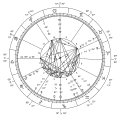In Indian astronomy and astrology, vyatipāta and vaidhṛti (or, vaidhṛta) are two moments in the regular motion of the sun and the moon in the zodiac characterized by their certain special relative positions. These terms are also used to denote two of the 27 Nityayoga-s: vyatipāta is the 17th nityayoga and vaidhṛti is the 27th nityayoga.
Definitions
Sūrysiddhānta defines vyatipāta and vaidhṛti as follows (Sūrysiddhānta Chapter IX Pātādhikāra verses 1 and 2):[1]
- When the sun and moon are upon the same side of either solstice, and when, the sum of their longitudes being a circle, they are of equal declination, it is styled vaidhṛta.
- When the moon and sun are upon opposite sides of either solstice, and their minutes of declination are the same, it is vyatipāta, the sum of their longitudes being a half-circle.
The term pāta in the present context means literally "fall," and hence also either "fault, transgression," or " calamity." The term was probably first applied to the moon's nodes, because they were the points of danger in her revolution, near which the sun or herself was liable to fall into the jaws of Rāhu. Why the time when the sun and moon are equally distant from the equator should be looked upon as so especially unfortunate is not easy to discover. When the equal declinations are of opposite direction, the aspect is denominated vaidhṛta, or vaidhṛti. It has been noted above that it is the name of the last nityayoga. The name of the other aspect (pāta), which occurs when the sun and moon are equally removed from the equator upon the same side of it, is vyatipāta, which may be rendered "very excessive sin or calamity." This, too, is the name of one of the nityayoga-s, but not of that one which occurs when the sum of longitudes of the sun and moon is 180 degrees.[1]
The specification that the pāata-s take place when the sum of longitudes equals a circle or a half-circle respectively, or when the two luminaries are equally distant from either solstice, or either equinox, is not to be understood as exact: this would be the case if the moon had no motion in latitude; but owing to that motion, the equality of declinations, which is the main thing, occurs at a time somewhat removed from that of equality of distance from the equinoxes: the latter is called madhyapāta, "the mean occurrence of the pāta."
Chapter XI Pātādhikāra of Sūrysiddhānta is devoted entirely to a discussion on vyatipāta and vaidhṛti. Among other things, the chapter discusses the malignant aspects of the pāata-s, methods to find the longitude of the sun and moon when their declinations are equal, methods to determine the duration of the aspect, and the moment of its beginning and end, etc. According to Burgess: "Of all the chapters in the treatise, this is the one which has least interest and value."[1]
Records of vyatīpāta-s in stone inscriptions
This term vyatīpāta appears in several stone inscriptions. The contexts of the inscriptions may be grants, donations to temples, records of death of war heroes, self-immolation of saints or women committing sati. A detailed study of these inscriptions has yielded valuable information about eclipses and other celestial events like planetary conjunctions.[2]
See also
References
- ^ a b c Ebenezer Burgess (1935) [1860]. Translation of the Sûrya-Siddhânta, A Text-Book of Hindu Astronomy; With Notes, and an Appendix. University of Calcutta. pp. 272–274. Retrieved 28 January 2024.
 This article incorporates text from this source, which is in the public domain.
This article incorporates text from this source, which is in the public domain.
- ^ B S Shylaja and Geetha Kydala (2016). "Records of Vyatīpāta in Stone Inscriptions". Indian Journal of History of Science. 51 (2): 206–216. Retrieved 23 January 2024.





